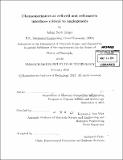Chemomechanics at cell-cell and cell-matrix interfaces critical to angiogenesis
Author(s)
Zeiger, Adam Scott
DownloadFull printable version (41.16Mb)
Other Contributors
Massachusetts Institute of Technology. Department of Materials Science and Engineering.
Advisor
Krystyn J. Van Vliet.
Terms of use
Metadata
Show full item recordAbstract
The ability to characterize and control cellular responses in vitro has far reaching implications for basic science and applied medical research. For well over 125 years, researchers have studied the behavior of biological cells under in vitro conditions where rigid glass or plastic Petri dishes and defined media in the laboratory replace the compliant solids and crowded fluids of the human body in vivo. While these tools have enabled several important advances in understanding cell functions and pathological mechanisms, the behavior of tissue cells in vitro can differ remarkably from those observed in in vivo tissue microenvironments. It is becoming increasingly appreciated that there is a close coupling between the chemical and mechanical microenvironments of the cell (i.e., the chemomechanical niche). Therefore, the biochemical reactions and conditions responsible for generating mechanical stresses and attendant cell behaviors may not be well represented in typical in vitro assays. In several key respects, particularly in terms of cell proliferation, adhesion, migration and phenotypic metabolism, in vitro assays often misrepresent the major characteristics of these behaviors in vivo. Most physiological processes are defined in part by mechanical force, mechanical microenvironment, and chemical stimuli (e.g., in angiogenesis or regulation of stern cell differentation), and therefore require an updated methodology to studying cellular mechanics and behavior. This thesis aims to address the molecular- to cellular-level chemical and mechanical environments that modulate cell function in vivo at the cell-cell and cell-matrix interfaces, while aiming to more accurately reproduce these cell responses in vitro. The experiments and analyses described in this work investigate two key questions at the heart of angiogenesis. First, how does the protein dense nature of tissue nicroenvironments affect extracellular matrix organization and, in turn, direct cell-matrix guided functions and cytoskeletal organization? This will be addressed by the addition of inert crowders which artificially enhance the effective concentration of relevant macromolecules and proteins in vitro. Second, how do the mechanically couplings and biochemical signals between adjacent, dissimilar cell types in the microvasculature coordinate and guide angiogenesis? Multiple types of deformable substrata will be used to investigate the mechanical strain and soluble growth factors generated by perivascular cells and the response of microvascular endothelial cells to those cues. This includes the development of a novel uniaxial strain-generating device and tissue culture surfaces for endothelial cells. Atomic force microscopy enabled imaging and nanoindentation, mechanically and chemically defined substrata, immunocyto-chemistry, and novel quanitification and analysis techniques are used concomitantly to answer these questions. Ultimately, this thesis aims to close the gap between in vitro cell culture and in vivo cell physiology, especially in directing and characterizing chemomechanical cues implicated in angiogenesis, and to inform the design of future experiments and microenvironments with non-dilute culture media and deformable substrata.
Description
Thesis: Ph. D., Massachusetts Institute of Technology, Department of Materials Science and Engineering, February 2014. Cataloged from PDF version of thesis. "February 2014." Includes bibliographical references.
Date issued
2014Department
Massachusetts Institute of Technology. Department of Materials Science and EngineeringPublisher
Massachusetts Institute of Technology
Keywords
Materials Science and Engineering.